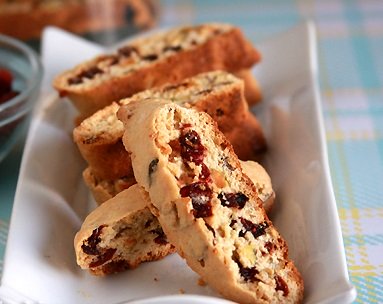leaveners
Choose what you're looking for here:
Baking Powder
Used in baking cakes, cookies, muffins and of course biscotti. When you add water to baking powder, the dry acid and base go into solution and start reacting to produce carbon dioxide bubbles. When the baked good is placed in the hot oven, the carbon dioxide production increase, give lift to the baked good.
Some baking powder contain wheat starch, which will be specified on the label. Gluten free baking powder is available in most markets, and can be substituted in equal amounts.
Baking powder is available in two forms:
Single-acting baking powder produces all of its bubbles when it gets wet, so you must bake recipes which include this product immediately after mixing.
Double-acting baking powder produces bubbles again when it gets hot. Some gas is released at room temperature when the powder come in contact with moisture in the dough, but the majority of the gas is released after the temperature of the dough increases in the oven. So mixed dough can stand for a while before baking.
If you can’t find baking powder you can make you own.
Recipe for baking powder (gluten free).
In a small bowl sift together 2 tsp cream of tartar, 2 tsp cornstarch or arrowroot starch and 1 tsp baking soda. Make only a small amount at a time and store in an air tight container.
Baking Soda
Baking soda is a common leavener used in baking, cookies muffins and biscotti when certain ingredients are also included. Baking soda is pure sodium bicarbonate. When baking soda is combined with moisture and an acidic ingredient (e.g., yogurt, chocolate, buttermilk, honey), the resulting chemical reaction produces bubbles of carbon dioxide that expand under oven temperatures, causing baked goods to rise. The reaction begins immediately upon mixing the ingredients, so you need to bake recipes which call for baking soda immediately, or else they will fall flat!
Baking Powder and baking soda perform similar functions during baking, but they react differently with the other ingredients so you can't always substitute one for the other.
Yeast is not a common leavener when it comes to baking cookies, muffins or Biscotti but here is a bit about it anyway
Yeast
Yeast is made up of a single-celled organism, Saccharomyces cerevisiae, which multiplies rapidly when fed sugar in a moist environment. As a leavener, yeast also thrives on starch, which it converts to glucose, a simple sugar. This process ferments the sugar, which converts to alcohol and carbon dioxide. The carbon dioxide expands the baked good to produce the light, fluffy texture.
The minimal alcohol product burns off during the baking process, and the yeast dies also with the heat.
Tip: Salt inhibits the growth of yeast. Never mix yeast into salted water. However, if you are baking during the hot summer season and find your dough rising too much, the addition of a little extra salt can control that runaway yeast growth.
Most yeast is sold in single-use packets or bulk bags known as dry active yeast. If the dry yeast is stored in airtight packaging, in a cool dry place, it is not necessary to refrigerate it. Yeast should always be at room temperature to begin a recipe.
Also available is fast-rising active dry yeast, which is smaller-grained than conventional active dry yeast and speeds rising times by as much as fifty percent. It may be used interchangeably, measure for measure, with active dry yeast. Because of the speed at which it raises, fast acting yeast can be mixed t directly with the dry ingredients before adding liquid, instead of starting by adding it to warmed liquid.
Dried yeast has become the norm for its staying power in the pantry. But some still use compressed fresh yeast. This yeast as a 70 percent moisture and must be stored in the refrigerator. Compressed fresh yeast is highly perishable, as opposed to dry active yeast, and loses its vitality within 2 weeks, even when properly stored, refrigerated in an airtight container. You can store in the freezer, but should be defrosted at room temperature and then used immediately.
Compressed fresh yeast is difficult to find in the United States.
Tip: Yeast measures will also have to be adjusted at higher altitudes. Again, this will take experimentation on your part for your altitude.
Back to Top of Leaveners
Questions or Comments?
Like a recipe or something you read? LET US KNOW!
Have a Question don't be shy, ASK US!
What's New
-
Almond Anise Biscotti
Jan 12, 15 04:43 PM
Almond Anise Biscotti -
Peanut Butter Biscotti
Jan 12, 15 12:41 PM
If you like peanut butter cookies, you will love these Peanut Butter Biscotti. -
Butterscotch Biscotti
Jan 10, 15 07:24 PM
These decadent Butterscotch Biscotti are made with a bit a extract and lots of butterscotch chips.













